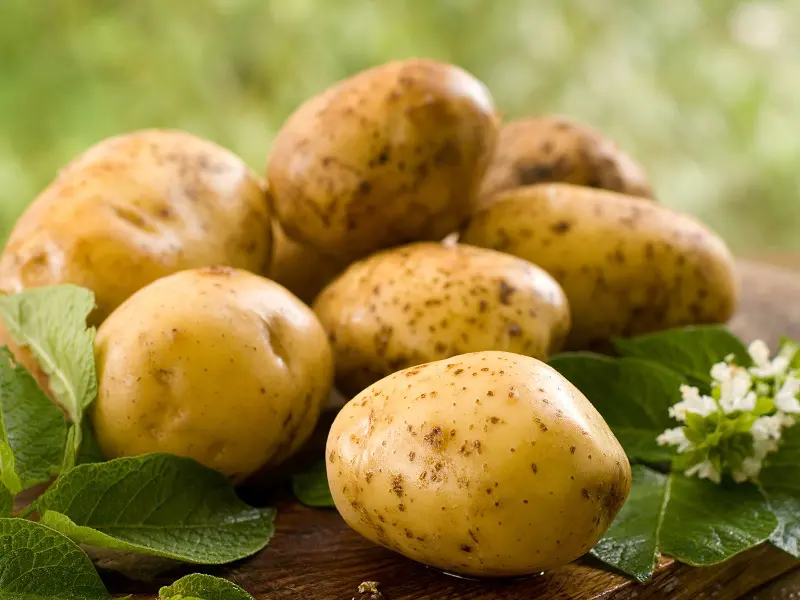Potato is a member of the nightshade family which includes tomatoes and aubergines. They are the underground energy stores (tubers) of the plant. There are many types of potatoes. But, from a culinary perspective, they can be divided into three categories: ‘floury, ‘waxy, and ‘new.
Maris Piper is a floury potato that’s packed with amylose starch. These starch grains swell when cooked and burst open to make the soft, fluffy mash. Waxy potatoes like Charlotte contain less amylose. This gives the potatoes a firm texture which is great for roasting and making gratins. New potatoes, however, are young potatoes that have been picked before the season ends. They retain their structure during cooking, which makes them ideal for potato salads.
Nutritious Benefits
A medium portion (175g), of boiled potatoes (flesh & skin), provides the following:
- 119kcal / 509kJ
- 3.1g protein
- 0.2g fat
- 26.1g carbohydrates
- 1.9g Sugar
- Fiber: 3.1g
- 12mg vitamin C
How potatoes are prepared and cooked will affect their nutritional value. Whole potatoes are best cooked in their skins to retain fiber and important nutrients like iron, magnesium, potassium, and zinc. Vitamin C and B6 levels decrease in cooking, while carotenoids (and some plant compounds called Polyphenols) increase.
Top 5 Health Benefits Of Potatoes
- Value For Money In Nutrition
The nutrient-to-price ratio of potatoes is higher than that of many vegetables. They are an essential staple in the world, contributes to the UK’s vitamin C, potassium, and vitamin B6 intakes. Potatoes are a great choice due to their ability to provide food quickly on smaller amounts of land, which is a benefit for a growing global population.
- Low In Fat
Many people, including health professionals, view potatoes negatively. But it’s important to remember that potatoes can be baked or boiled and they are virtually fat-free. The starch in tubers is higher than that of rice and pasta, but they are lower in calories. They are also rich in micronutrients such as folate and vitamin C, which is something that pasta and rice don’t have.
While potatoes are low in protein, their protein is precious and has a high biological value. It provides a good distribution of amino acids that are essential for our health.
- Supports Gut Health
Starch from potatoes is a good source of fiber and beneficial food for our gut microbes. It’s resistant starch,’ meaning that it’s not digestible by us, but can be broken down and used as fuel for our gut bacteria.
After potatoes have been cooked and cooled, starch granules become more resistant to digestion. Studies have shown that foods rich in resistant starch provide a host of health benefits. These include more efficient digestion, less chance of chronic diseases, and a lower risk of colon Cancer.
- May Support Blood Sugar Management
Potatoes, rich in resistant starch may improve blood sugar control and reduce appetite. Research on animals has shown that potatoes have a higher insulin sensitivity and less fat accumulation. A four-week study of the effects of 30 grams each day of resistant starch over a period revealed that this effect appears to be reproducible in healthy people. Remember that potatoes can be increased in resistant starch by being boiled, cooled, and stored in the fridge.
A valuable source of a type o fiber called pectin, potatoes can also be used. This fiber slows down your stomach emptying, helps you feel fuller for longer, and lowers the effects of food on blood sugar.
- Source For Protective Antioxidants
Potatoes provide a good source of phytochemicals that have a protective antioxidant function. The flesh of potatoes contains lutein, zeaxanthin, and carotenoids that are good for the eye. Also, potatoes are a good source of flavonoids and chlorogenic acid.










